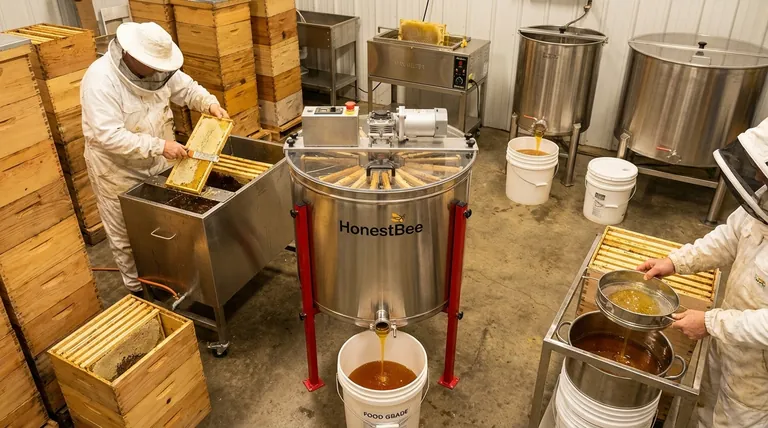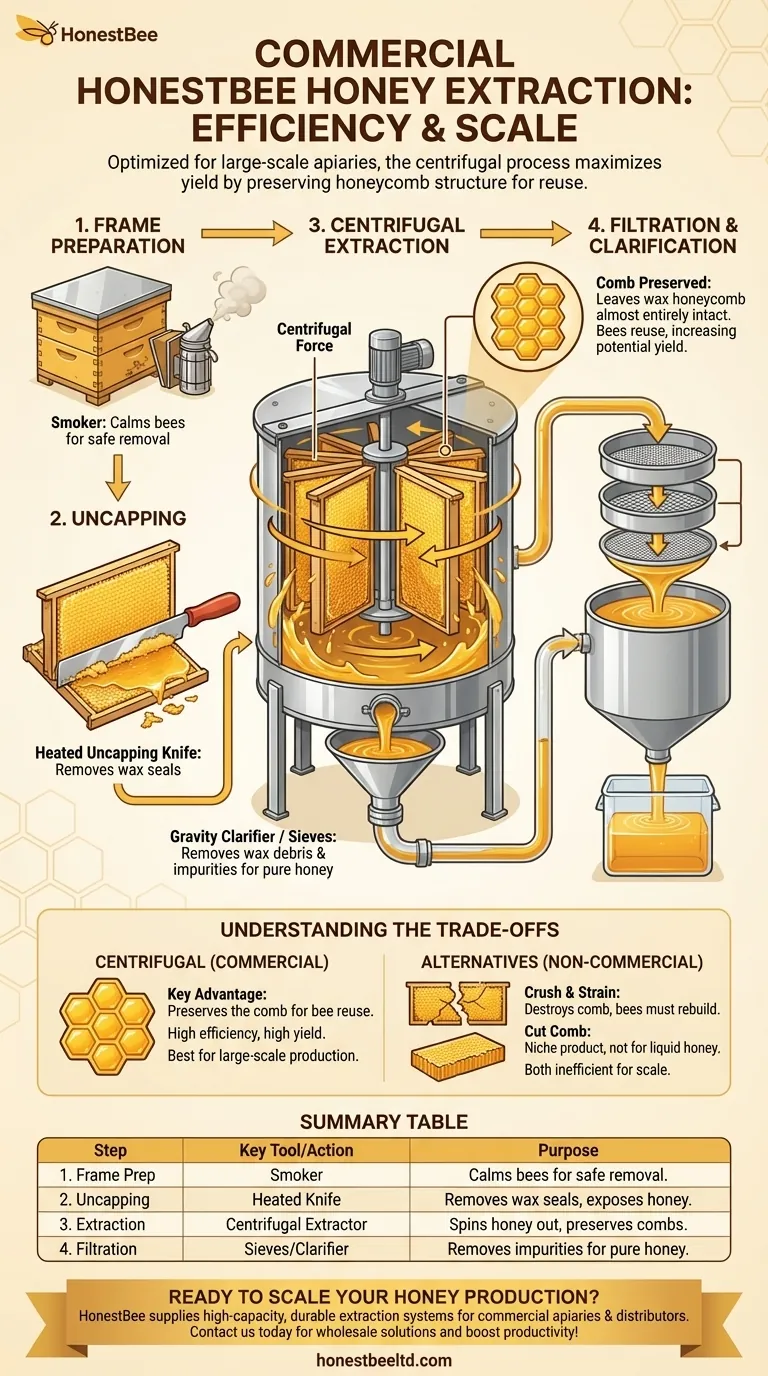In commercial beekeeping, honey is extracted from the comb not by crushing or squeezing, but by using a large, motorized machine called a honey extractor. This device uses powerful centrifugal force to spin the honey out of the uncapped honeycomb cells, allowing for rapid and efficient processing of honey from hundreds of hives while preserving the delicate wax comb for the bees to reuse.
The core principle of commercial honey extraction is maximizing efficiency and yield. The entire process is built around a system that can quickly process large volumes of honey with minimal damage to the beehive's existing infrastructure, namely the wax combs.

The Commercial Extraction Process: A Step-by-Step Breakdown
To understand commercial extraction, it's best to view it as a production line designed for speed and purity, moving from the hive to the storage tank. Each step is optimized for large-scale operations.
Preparing the Frames for Extraction
Before any honey can be extracted, the honey-filled frames must be removed from the hive supers—the boxes stacked on top of the main hive body.
Beekeepers use a tool called a smoker to puff cool smoke into the hive, which calms the bees and encourages them to move away from the frames, making them safe to handle and remove.
The Critical Step of Uncapping
Honeybees seal each cell full of ripened honey with a thin layer of beeswax, known as "capping." This capping must be removed before the honey can flow out.
In a commercial setting, this is done with a heated uncapping knife or a specialized uncapping fork. These tools slice off the wax cappings cleanly, exposing the liquid honey within the cells.
Inside the Centrifugal Extractor
The uncapped frames are immediately placed into the honey extractor. This machine is essentially a large, stainless steel drum with a motorized rotating rack inside.
As the extractor spins at high speed, centrifugal force flings the liquid honey out from the honeycomb cells and onto the inner wall of the drum. The empty but intact combs are left behind.
Filtering and Clarification
The raw honey flows down the extractor's walls and collects at the bottom, where it is drained. This honey contains particles of beeswax and other hive debris.
It is then pumped through a series of filters or sieves to remove these impurities. Some large operations also use a gravity clarifier, a large tank where honey sits, allowing wax to float to the top and heavier sediment to sink, resulting in a cleaner final product.
Understanding the Trade-offs: Efficiency vs. Other Methods
Centrifugal extraction is the dominant commercial method for a clear reason, but it's not the only way to get honey from a comb. The alternatives highlight the specific trade-offs made in large-scale production.
The Key Advantage: Preserving the Comb
The single greatest advantage of centrifugal extraction is that it leaves the wax honeycomb almost entirely intact.
Bees expend a tremendous amount of energy to produce wax and build these combs. By returning the empty combs to the hive, beekeepers allow the bees to immediately start refilling them with honey instead of spending weeks rebuilding the structure from scratch. This dramatically increases the hive's potential honey output.
The "Crush and Strain" Method
An alternative, lower-tech method involves crushing the entire honeycomb and straining the mixture to separate the honey from the wax.
While simple, this method destroys the comb, forcing the bees to start over. It is typically only used by hobbyists or for processing cappings wax, as it is far too inefficient for commercial scale.
The "Cut Comb" Method
This method involves simply cutting out sections of the sealed honeycomb to be sold as-is.
This is not a method for producing liquid honey but rather a specialty product. It avoids extraction entirely but serves a completely different market.
Making the Right Choice for Your Goal
The method of extraction is dictated entirely by the scale and objective of the beekeeping operation.
- If your primary focus is large-scale commercial production: Motorized, centrifugal extraction is the only viable option for achieving the necessary speed, efficiency, and yield.
- If your primary focus is small-scale or hobbyist beekeeping: A small manual crank extractor or the crush-and-strain method are practical and cost-effective choices.
- If your primary focus is creating a niche or artisanal product: The cut comb method or a minimally filtered crush-and-strain process can produce a more rustic product that commands a premium price.
Ultimately, understanding these methods reveals how the journey from flower to jar is optimized for the intended final product.
Summary Table:
| Step | Key Tool/Action | Purpose |
|---|---|---|
| 1. Frame Preparation | Smoker | Calms bees for safe frame removal from hive supers. |
| 2. Uncapping | Heated Uncapping Knife | Removes wax seals to expose honey in cells. |
| 3. Extraction | Centrifugal Honey Extractor | Spins honey out using centrifugal force, preserving combs. |
| 4. Filtration | Sieves/Gravity Clarifier | Removes wax debris and impurities for pure honey. |
Ready to scale your honey production? HONESTBEE supplies commercial apiaries and beekeeping equipment distributors with high-capacity, durable extraction systems—from motorized honey extractors to uncapping tools. Our wholesale-focused solutions help you process hundreds of hives efficiently while preserving comb integrity for higher yields. Contact us today to discuss your operation's needs and boost your productivity!
Visual Guide

Related Products
- Electric 8 Frame Honey Spinner Extractor Equipment for Beekeeping
- HONESTBEE 72 Frame Industrial Electric Honey Extractor for Beekeeping
- electric honey extractor honey centrifuge 3 frame honey extractor stainless steel honey frame extractor
- 2 Frame Stainless Steel Manual Honey Spinner Extractor for Beekeeping
- 40 Frame Commercial Electric Honey Extractor for Beekeeping
People Also Ask
- What is an extractor in beekeeping? Unlock Sustainable Honey Harvesting
- Why is cleaning a honey extractor important in beekeeping? Protect Your Honey Quality & Equipment
- What are the benefits of using a honey extractor? Maximize Harvest & Save Bee Energy
- What machines are needed in beekeeping besides basic tools? Scale Your Honey Harvest Efficiently
- What are the best storage conditions for a honey extractor? Protect Your Investment for Next Season



















